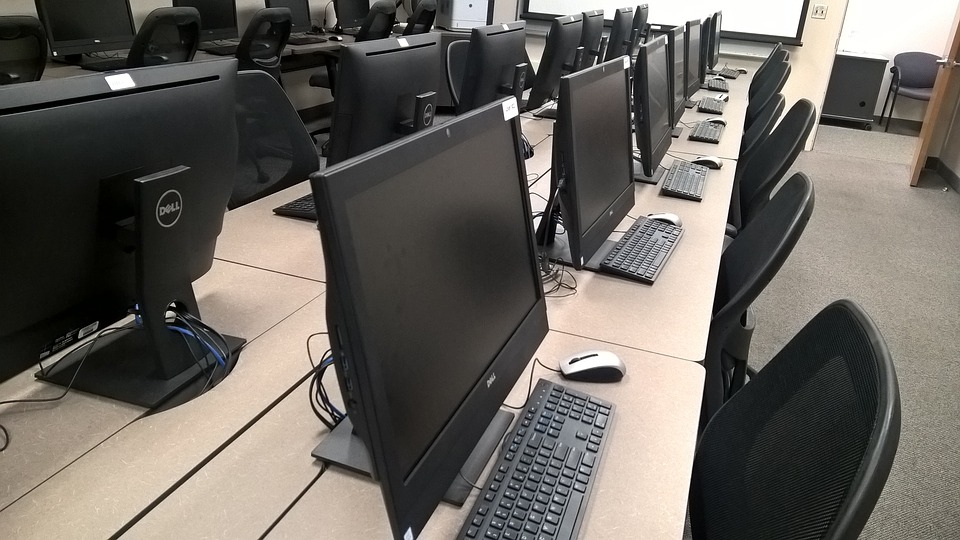Is there still a place for language labs in higher education? Posted by Transparent Language on Feb 26, 2018 in Archived Posts
When you hear “language lab”, you probably picture rows of computer desks, occupied by headphone-clad students working on some kind of project. But the modern language center has evolved far beyond a computer lab.
Language centers serve as community and cultural centers on campus.
The term “lab” is no longer an accurate title, as it indicates a simple computer lab, where students can record a poem recitation or watch videos in the target language. But language centers (as more schools and organizations now call them) are no longer just homes for computers. Language centers are home to diverse, engaged communities of language educators and learners.
The modern language center is a space for collaboration and community-building.
Centers provide a venue for group study, conversation circles, presentations, and tutoring sessions. The Bard College Language Center, for example, hires international students who tutor in languages offered at Bard or serve as ambassadors to other languages and cultures not offered formally on campus. Given that 95% of all language enrollments are in a European language, leveraging student diversity allows students to access less common languages.
Investing in students this way, allowing them to collaborate and contribute to the center’s mission, builds community. For higher ed institutions, fostering this sense of community can be as important as academics when it comes to student retention and success.
The modern language center introduces the campus to other cultures.
Language is, of course, a gateway into culture—language centers have evolved to reflect that. Many centers provide a dedicated space for film screenings, music and dance performances, cooking demonstrations, and beyond. These events encourage diversity and cultural awareness on campus, creating an environment that mirrors what students will find when they enter the workforce.
While language labs were once known for computer access and an internet connection, language centers have transformed to focus on human connection. Supplementing language study with an interactive, multi-cultural environment encourages soft skills highly desired by employers in a number of fields.
Language centers can help revive language study, bridging the critical gap in language skills.
In addition to soft skills, language centers have a clear and critical mission of building language skills, which are experiencing a major deficit in the U.S. As former Secretary of Education Arne Duncan pointed out, “To prosper economically and to improve relations with other countries […] Americans need to read, speak and understand other languages.”
Despite the growing need for “diplomats, intelligence and foreign policy experts, politicians, military leaders, business leaders, scientists, physicians, entrepreneurs, managers, technicians, historians, artists, and writers” who speak other languages, the number of American universities requiring language study for graduation has decreased. According to the Modern Language Association, the number of four-year universities requiring foreign language courses dropped 17% between 1995 and 2010, leaving only about 50% of schools demanding language study. This lack of language skills constitutes a national emergency according to the American Academy of Arts and Sciences.
LeeAnn Stone, former President of the International Association for Language Learning Technology (IALLT), understands the value of dedicated language center as a recruitment tool. She believes the language center should be “the central hub for a much-needed new focus for language education in the U.S.”, involving a cross-disciplinary language curriculum that makes language interesting and relevant to today’s learners:
“Given the continuing decrease in language offerings, requirements, and enrollments in higher ed institutions, even despite the general growth of language learning interest external to that environment, the [language center] can be poised to help capture enrollments and revive the discipline.”
Dr. Mikle Ledgerwood has also seen the positive impact of the Language Technology Forum (LTF) at Samford University:
“I love going into the LTF and interacting with students and their leaders in their conversation activities and messing with all groups in a very gentle way in Spanish, French, and German. I really think the LTF was very important in World Languages and Culture [department]’s growth of 10.5% over the last three years.”
At a time when America risks being left out of any conversation not in English, language centers provide a place for all students from all degree programs to interact with languages and cultures. Self-guided language courses, cultural events, tutors, and conversation groups prepare future engineers, doctors, marketers, politicians, and beyond to participate in the global conversation.
Modern language centers cannot be replaced by libraries or computer labs.
Despite the benefits to universities, students, and their future employers, language centers face budget cuts or even closure. Coordinators and educators find themselves trying to justify the existence of language centers—a question that should be rhetorical.
Opponents suggest that computer labs, study spaces, and campus libraries can serve as substitutes for language centers. That’s a bit like suggesting the school soccer team practice on a field in the park instead of at a dedicated facility. Sure, it provides a space for the activity, but does nothing else to support the efforts or nurture the skills of those involved.
The language center is a library in its own right.
As Stone envisions it, the future lies in language for specific purposes (LSP), where higher ed language programs focus on learning for meaningful communication in professional domains. As it stands, many high-level language courses at the university level focus on literature. As programs shift focus to preparing culturally competent speakers, Stone argues the language center will play “an even more integral role in aggregating the very disparate informational, learning, and other resources and relationships necessary to support a more content-based, student-center, specific-purpose driven curriculum.”
While the language center is an obvious place for student communication and collaboration, the same can be said for faculty and staff. The modern language center is it’s own library—a place for the collective resources of language professors, other departments, and even other institutions.
Computer labs and language technology cannot replace teachers, but teachers who use these resources well can replace those who do not.
You can count the times we’ve argued the language centers are more than just computer labs, but that doesn’t mean the language center is not an innovative tech hub. Beginner language students and Humboldt State University in California step through self-guided online courses to fulfill a required lab credit. This effort requires little to no extra work on the part of instructors, but the learning done online supports in-class and real-world activities. This is same model Transparent Language has proven effective in all of our training programs; we call it Declaratively Accelerated Blended Learning.
Is there still a place for language centers in higher ed?
The benefits of a well-run language lab trickle down from the institution to its students and even all the way down to their future employers.
- For institutions of higher ed, language centers can refocus language programs to be domain-specific and student centered; recruit and retain talented students from all disciplines; and increase exposure to less common languages not formally offered on campus.
- For students, centers create a sense of community, inject languages into all courses of study, and build both hard and soft skills needed after graduation.
- For employers—public and private—employees skilled in languages can translate to new markets and better leadership.
To those wondering if there’s still a place for language labs (or centers) in higher ed, we would argue that modern language centers are at the very heart of language learning in higher ed. The evolving role of the language center does not just support language education, it is the epicenter of a major transformation that Stone believes “could revive language learning at the higher ed level”.
Looking for actionable advice and examples of how to evolve your language center beyond a computer lab? We recommend IALLT’s publication From Language Lab to Language Center and Beyond: the Past, President, and Future of Language Center Design.
Looking for an online language learning platform for your language center? We invite you to explore Transparent Language Online, including how other universities leverage its content and admin features.

Build vocabulary, practice pronunciation, and more with Transparent Language Online. Available anytime, anywhere, on any device.






Comments:
Yvonne:
Hello,
I haven’t read the whole article for “editing”, but this sentence caught my eye immediately.
The language center is it’s own library.
it’s – should be – its.
Also, did you mean the language center has its own library?
Transparent Language:
@Yvonne Thanks for catching that ugly typo. We’ve corrected it and hopefully clarified that statement to convey that language centers are another type of library not easily replaced or replicated by a traditional campus library.